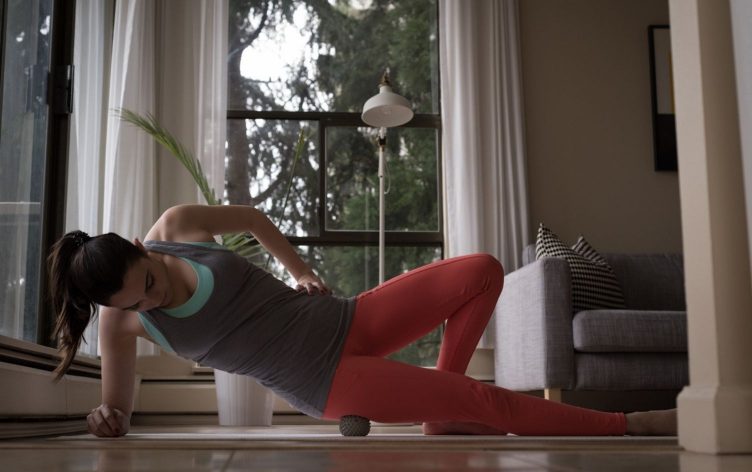
5 Self-Massage Alternatives to Relieve Aches and Pains
Few things feel better on sore, tight muscles than a massage.
Massages offer plenty of benefits: “Any type of massage or soft tissue release helps improve blood flow and circulation, drain and move stagnant lymph, and remove toxins stuck in the layers between the muscle and the fascia,” says Bianca Beldini, DPT, a licensed acupuncturist and dry needling expert who practices in New York City. (Lymph is a pale fluid made up of white blood cells that surrounds all our tissues, while fascia is a connective tissue that wraps around structures like organs, bone tissue and skeletal muscles.)
However, as professional massages aren’t widely doable in today’s world, many of us have to get creative with our soft tissue work. Thankfully, there are many ways you can score the benefits of a professional massage without ever leaving your house.
GUA SHA
Gua Sha (also known as cao gio, coining, scraping and spooning) is a traditional Chinese medicine technique that involves scraping the skin with a rounded or flat-end tool to increase blood flow to the soft tissues closer to the skin’s surface. Bringing more blood to these superficial tissues warms them up, helping to make them more pliable and decreasing pain, according to Beldini.
Past research in the journal Explore reveals that applying a single Gua Sha treatment to a small group of adults increased circulation by four times the usual amount for nearly 8 minutes following the treatment. Each person also experienced immediate pain relief at both the treatment site studied (the back), as well as areas where Gua Sha wasn’t applied.
You can actually practice Gua Sha on yourself. There are scraping tools you can buy, or you can simply use the cap from your vitamin bottle, Beldini says. Just make sure the cap has a smooth, rounded edge; you don’t want to use a cap with a serrated edge.
How to do it: To perform Gua Sha, rub lotion or oil into the site you want to scrape. Then, press the smooth, rounded edge of a spoon or a bottle cap (or the edge of the Gua Sha scraping tool) into your moisturized skin with moderate pressure, and push it across the site. Push the scraper along the length of the muscle, avoiding joints and bones. Once you’re done scraping, you’ll notice your skin turn red immediately. But don’t be alarmed; redness indicates you’re pulling all the stagnant blood and lymph up to the surface, Beldini says.
Remember that Gua Sha shouldn’t be painful, so ease the pressure if scraping your skin makes you wince.
PERCUSSION THERAPY
Handheld percussion massagers like the Hyperice Hypervolt and the Theragun emit bursts of pressure through the attachment heads. When pressed into the muscles, percussion massagers work to improve circulation and blood flow, as well as dull muscle discomfort and pain. “If you give a different stimulus to the tissue, it changes the way the brain experiences the pain,” Beldini explains.
How to do it: Rub the percussion massager on sore, tight muscles; avoid joints and bones. Use the massager until you feel a change in the muscle tissue (i.e., less pain and discomfort), but for no longer than a few minutes in one area. “Usually, there’s an immediate response, and if you don’t get that, move on [to another spot],” Beldini says. If you work at a muscle for too long, or apply too much pressure, you risk irritating the tissue.
Experiment with the attachment heads, speed settings and pressure until you find a combination that loosens the tissues without causing any pain.
FOAM ROLLING
Foam rolling helps release tension in muscles and connective tissue, boosts blood flow and circulation, and improves range of motion. A 2015 review in the International Journal of Sports Physical Therapy suggests foam rolling may also lower delayed-onset muscle soreness (DOMS), the soreness that typically creeps up 12–24 hours after a hard workout.
How to do it: Position yourself on top of a foam roller so you can roll over target muscles. Move yourself back and forth on the roller until the target muscles feel looser (the review above suggests 30–60 seconds), and keep the pressure comfortably hard; you shouldn’t feel any pain as you foam roll.
When foam rolling, steer clear of your iliotibial (IT) band, a long piece of thick, connective tissue that runs along the outside of your leg from your hip to your knee that causes issues for runners in particular. “I have the biggest issue with the IT band being rolled out because it’s not even a muscle,” Beldini says. Plus, foam rolling the IT band tends to be very painful for many people — often to the point where it’s impossible to relax, she adds. If you want to soften your tissues, you have to be able to relax your muscles.
COMPRESSION WITH LACROSSE BALLS
Like foam rolling, you can use tools like lacrosse, tennis and golf balls to release muscle tension on your own. However, lacrosse, tennis and golf balls can help you target smaller, harder-to-reach spots, like the area beneath the shoulder blades.
How to do it: To ease muscle tension and pain, position yourself over a lacrosse or tennis ball and allow the ball to press into the target area. You can also perform small movements on top of the ball (i.e., rolling your hips) to help soften your tissues even more. “Instead of rotating the balls, use the ball as a stationary object and simply move on top of that object,” Beldini says. Use the ball for a few minutes in each target area, and don’t use the ball on joints or bones. Ease the pressure if you feel any pain in your muscles.
EPSOM SALT BATH
A hot Epsom salt bath can help your muscles relax — adding Epsom salt (made up of magnesium sulfate) takes things to the next level, as magnesium sulfate is a natural muscle relaxant: “Magnesium sulfate helps to dilate the blood vessels and get things to flow and relax,” Beldini says.
How to do it: Add about a cup of epsom salts to warm water and soak for at least 15 minutes. To squeeze even more muscle-relaxing benefits out of your tub time, Beldini suggests doing some light stretches and self-massage work while you soak.
Unlock an experience that’s like having a dietitian, trainer and coach at your fingertips. Sign up for Premium for expert guidance and tools to help you reach your personal health goals.





